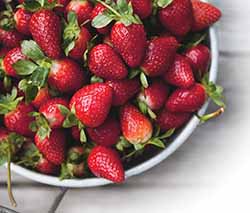Strawberries and sweetness; Crop homogeneity
NEWS
 Strawberry compounds enhance ‘sweetness’
Strawberry compounds enhance ‘sweetness’
Researchers have isolated naturally occurring compounds in strawberries that heighten tasters’ perception of sweetness independent of actual sugar levels, according to a study published in Plos One. Strawberries may offer potential as a way to add the perception of sweetness to foods without using additional sweeteners.
In the study, researchers grew 35 kinds of strawberries over two seasons, then asked a panel of 166 tasters to evaluate the berries’ sweetness, sourness, and strawberry flavor, as well as their overall liking of the fruit. Researchers found perceived sweetness intensity to be the greatest predictor of overall liking, followed by intensity of strawberry flavor.
As the season went on, sugars and volatile compounds in the berries decreased, and tasters rated strawberries less favorably. However, the researchers found that the presence of certain volatile compounds improved tasters’ perceptions, and six of these volatiles were shown to improve the perception of sweetness independent of actual sugar content.
“These findings allow for consumer influence in the breeding of more desirable fruits and vegetables,” wrote the researchers. “Also, this approach garners insights into fruit metabolomics, flavor chemistry, and a paradigm for enhancing liking of natural or processed products.”
The study, “Strawberry Flavor:Diverse Chemical Compositions, a Seasonal Influence, and Effects on Sensory Perception,” appeared in Plos One; doi: 10.1371/journal.pone.0088446.
2014 trends in food safety testing
Increased worldwide microbiology testing and an uptick in contract testing labs are among the five food safety testing trends Strategic Consulting Inc. predicted for 2014.
With new regulations being established and public concern about and media coverage of food safety growing, testing at processing facilities is increasing.
--- PAGE BREAK ---
Food safety testing at processing facilities is on the rise, thanks in part to heightened public concern over food safety and increased media coverage of expensive recalls that damage brand reputations. Some of these facilities are taking advantage of Rapid Microbial Methods, which are easier and faster to use, making them more cost effective. Establishing food safety testing labs is an expensive investment, though, and some plants are relying instead on contract testing laboratories, which have the expertise and accreditation that the companies may lack.
Newly established regulations such as the Food Safety Modernization Act will also require plants to increase environmental testing to look for pathogens. One such pathogen of major concern is Salmonella, which will factor more heavily in food safety discussions this year.
The report was produced based on interviews with quality assurance/control managers and food safety experts in academia, government, and industry around the world.
Fewer Americans report eating healthily ‘yesterday’
Only 63.8% of Americans said they ate healthily all day “yesterday” in 2013, according to self-reported data gathered by Gallup and Healthways. That percentage is the lowest reported in any year since 2008, down from a high of 67.7% in 2010. This may not be surprising, said Gallup, as 2013 also saw the obesity rate jump to an all-time high of 27.1%.
Healthy eating habits differed across income levels, with lower-income groups reporting eating healthily more frequently than middle- and upper-income Americans, a trend that has held steady across previous years. In spite of this, lower-income Americans are more likely to be obese than upper-income Americans; they may believe their food intake to be more nutritious than it actually is. Middle-income groups continued to report the lowest levels of healthy eating and also experienced the greatest drop, from 65% in 2012 to 61.8% in 2013.
The percentage of Americans who reported eating at least five servings of fruits and vegetables four days a week, however, held steady, even as more Americans reported having trouble affording the food they need and experienced more difficulty finding affordable fruits and vegetables. Upper-income Americans reported the highest rate of eating produce, and lower-income groups reported the lowest rate.
--- PAGE BREAK ---
Homogeneity of crop plants on the rise
National food supplies worldwide have become more similar in composition to each other over time, creating interdependence among countries in their food supplies, plant genetic resources, and nutritional priorities, according to a study published in PNAS.
Over the past 50 years, per capita food supplies expanded in total quantities of food calories, protein, fat, and weight, and the number of types of commodities contributing to these national food supplies also increased. Countries experienced greater diversity of crops at a national level, but the number of crops across countries became more even, reducing the overall global diversity of crops.
As a result, countries now experience greater interdependence among themselves regarding availability and access to these food sources and the genetic resources supporting their production. The researchers believe these findings strengthen arguments for creating nutrition development priorities aimed at bolstering food security.
The study, “Increasing homogeneity in global food supplies and the implications for food security,” appeared online early in PNAS, doi: 10.1073/pnas.1313490111.
 Imagining smells leads to increased eating
Imagining smells leads to increased eating
"Smellizing”—imagining the smell of a certain food—may make people eat more of it, according to a study published in Journal of Consumer Research.
In the study, researchers showed participants a picture of cake or cookies and asked them to either imagine how they smelled or simply look at the images; some people were asked to actually smell the cake. The people who were asked to actually smell or imagine the smell of cake salivated more than those who just saw the picture, and they subsequently consumed more of the desserts. The inclusion of the food’s picture, though, was necessary; salivation did not increase when participants were asked to imagine the scent without seeing an image of it.
The study, “Smellizing Cookies and Salivating: A Focus on Olfactory Imagery,” appeared in Journal of Consumer Research, doi: 10.1086/674664.
--- PAGE BREAK ---
What’s new with food companies
• Archer Daniels Midland Co. announced plans to build a soy protein production complex in Campo Grande, Mato Grosso do Sul, Brazil.
• Barry Callebaut introduced its Power Flowers system, a line of flower-shaped food colorant pellets, to allow for less messy, heat-free chocolate color customization.
• Bayer CropScience broke ground on an expansion of its site in Wismar, Federal State of Mecklenburg-Vorpommern, Germany, to include a new biological crop protection production facility.
• Cargill invested 8 million euro to expand its European Research and Development Centre in in Vilvoorde, Belgium, and it will expand its specialty cocoa liquors capabilities in its plants in France and Germany.
• COFCO Corp. signed an agreement to acquire 51% of Nidera and establish the largest ever strategic cooperation by an agricultural enterprise between the Netherlands and China.
• Fonterra began construction on a new blending and packing plant in West Java, Indonesia, its largest Southeast Asian manufacturing investment in the last 10 years.
• Goya Foods opened new manufacturing, production, and distribution facilities in California, Georgia, New Jersey, and Texas to expand its healthy product lines.
• Greencore Group PLC will close its facilities in Massachusetts to open a 107,000-square-foot sandwich manufacturing facility in Quonset, R.I.
• Hershey announced its commitment to using only Fair Trade-certified cocoa by 2020.
• Invisible Sentinel’s rapid diagnostic for the detection of Salmonella has been awarded Association of Analytical Communities certification.
• Lindt & Sprüngli announced plans for a multimillion dollar expansion of its Stratham, N.H., headquarters.
• Mars announced its commitment to sourcing fully sustainable and traceable palm oil by the end of 2015 and only Fair Trade certified cocoa by 2020. It also opened its first new plant in 35 years near Topeka, Kan.
• Mondelez International unveiled its new Call for Well-being strategy to improve global health. It will focus on mindful snacking, sustainable agriculture, safe products, and promoting healthy lifestyles within communities.
• Nathan’s Famous Inc. entered into an agreement with John Morrell Food Group, a business unit of Smithfield Foods Inc., to distribute Nathan’s branded hot dogs, sausages, and corned beef nationally.
• Nestlé opened a food safety research center in Beijing, China, to help provide a scientific framework in applying food safety policies and standards.
• Peco Foods will build a fully integrated poultry complex in northeastern Arkansas, which is expected to create 1,000 new jobs.
• Food safety company RF Biocidics announced that it has formed a strategic partnership with STALAM, which develops, designs, and manufactures radio frequency (RF) equipment. RF Biocidics also formed a partnership with date producer Al Foah to market and distribute the first RF process for the disinfestation of dates in the Gulf Cooperation Council.
• Senomyx received Generally Recognized as Safe determination for its Sweetmyx sweetener enhancer.
• SensoryEffects acquired the Sleepy Eye, Minn., manufacturing facility of Anderson Custom Processing.
• Sterigenics entered into a definitive agreement to acquire Nordion Inc., a provider of medical isotopes and sterilization technologies headquartered in Ottawa, Ontario, Canada.
• Tate & Lyle PLC acquired Winway Biotechnology, which produces polydextrose specialty fiber in China. It also announced that it will expand its direct sales capabilities in Japan and open a new office in Tokyo.
• Private equity investment firm Wind Point Partners announced it will sell portfolio company Hearthside Food Solutions to Goldman Sachs and Vestar Capital.
 Melanie Zanoza Bartelme,
Melanie Zanoza Bartelme,
Associate Editor
[email protected]
